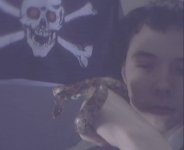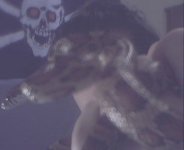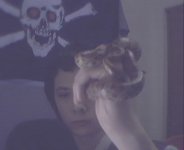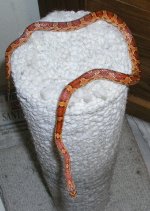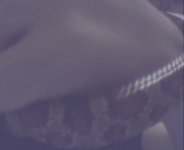-
Hello!
Either you have not registered on this site yet, or you are registered but have not logged in. In either case, you will not be able to use the full functionality of this site until you have registered, and then logged in after your registration has been approved.
Registration is FREE, so please register so you can participate instead of remaining a lurker....
Please be certain that the location field is correctly filled out when you register. All registrations that appear to be bogus will be rejected. Which means that if your location field does NOT match the actual location of your registration IP address, then your registration will be rejected.
Sorry about the strictness of this requirement, but it is necessary to block spammers and scammers at the door as much as possible.
You are using an out of date browser. It may not display this or other websites correctly.
You should upgrade or use an alternative browser.
You should upgrade or use an alternative browser.
My best friend :)
- Thread starter Mike55520
- Start date
robertwallace
Corns Rock
Cool snake,enjoy
Also ask questions on how to care for your new snake.
learn,learn,and learn
Also ask questions on how to care for your new snake.
learn,learn,and learn
MegF.
That's for sale???
Probably a hypo. From what I can see in the photos when I looked again, it doesn't see like he has really dark boarders around the saddles. It would be great if you could get a better photo. Here's a picture of one my Aztec Okeetees. She's het for amel, so she's hypo. She doesn't have a lot of black on her, just enough to give her dark eyes,light boarders, and somewhat dark checkering on her belly.
Attachments
gardenmum
Hopelessly Addicted
Well, the pictures are dark but I would definitely say that it looks like a normal. I don't see hypo in that snake. It has definite borders and black belly patches and hypo brightens the color of a normal and that one appears to be definitely non-brightened. So, I would say normal.
And as for age, I would agree with the 1 yr. or more. Definitely too large for just a few months.
Welcome to the forums and congratulations on your first corn. They're great snakes for sure.
And as for age, I would agree with the 1 yr. or more. Definitely too large for just a few months.
Welcome to the forums and congratulations on your first corn. They're great snakes for sure.
darkpbstar
New member
I too am sayign normal, and my corn is a year old and 4 months, and she isnt' as big/thick as that one, so maybe mine is just growing slower or somehting, but looks a little older htan a year.
Menhir
Charmelippe
MegF. said:Here's a picture of one my Aztec Okeetees. She's het for amel, so she's hypo.
Could you please explain that?
MegF.
That's for sale???
Well, I had someone explain that the hypo gene is a seperate gene. I didn't get an explanation if the amel gene she carries has helped to wash out some of the black in her, making her look like a hypo. The breeder told me that she has a lot less black, due to the amel gene. She certainly has smaller, almost non-existant borders for an Okeetee. She was bred from a pure Okeetee(I'm pretty sure that's what Mike told me) that goes back to wildcaught, and an amel. My new Okeetee's are from the same place, but are pure back to w/c on both parents, and their borders are quite pronounced. Do you know if the amel gene would cause a washing of the black?
Menhir
Charmelippe
Imho, the less black comes from the Amel parent. It isn't said that a normal Amel (perhaps not a Reverse Okeetee) must give many black or thick borders to their children.
You are comparing Okeetee x Okeetee to Okeetee x Normal in the matter of thick black borders and I think that's where the reason for the less black is and not that the animal is het. Amel.
I've never heard of distingushing het. Amels from not het. Amels by their "Hypo" look.
You are comparing Okeetee x Okeetee to Okeetee x Normal in the matter of thick black borders and I think that's where the reason for the less black is and not that the animal is het. Amel.
I've never heard of distingushing het. Amels from not het. Amels by their "Hypo" look.
MegF.
That's for sale???
Hmm, but an amel is not normal. It's lacking all black, so it's not going to give any black at all unlike a normal. The Okeetee parents that I saw pictures of, all have large borders, as do the hatchlings that I got that were from Okeetee X Okeetee. I'm still trying to figure out this genetics thing!! Should have payed more attention in biology! Just couldn't get into sweet pea plants I guess....
drizzt_19
What goes here???
MegF. said:Hmm, but an amel is not normal. It's lacking all black, so it's not going to give any black at all unlike a normal. The Okeetee parents that I saw pictures of, all have large borders, as do the hatchlings that I got that were from Okeetee X Okeetee. I'm still trying to figure out this genetics thing!! Should have payed more attention in biology! Just couldn't get into sweet pea plants I guess....
Meg,
Okeetee's are nothing but a specific locality cornsnake...Meaning they are normals...The amel gene has nothing to do with the fact that your snake does not have the bold black borders of an okeetee...
HTH,
Serpwidgets
New member
The parents do not give black or red to their offspring, they each give genes that tell each individual cell in the offspring how to make those pigments. The cells then produce the pigments on their own.MegF. said:Hmm, but an amel is not normal. It's lacking all black, so it's not going to give any black at all unlike a normal.
One copy of the normal (non-amel) gene can produce as much melanin as the snake needs. This is why hets are identical in appearance to non-hets, and why amel is a recessive trait and not codominant.
If what you said were true, you would be able to breed an amel to a normal and produce an entire clutch of "hypos." You could then breed those "hypos" to a normal and produce a clutch of both "hypos" and "normals." It would also be true that there would be no "possible hets" for amel.
Either you misunderstood the person who told you that, or they didn't know what they were talking about.
MegF.
That's for sale???
Drizzt: I know that Okeetee are a normal variant, but I would expect breeding two snakes that have a gene for large borders would also beget those with the same. Now, would the amel parent have given the gene for the smaller borders on my snake, or is that another recessive trait somewhere back on the Okeetee's side that popped out. Can you see my eyes glazing over with confusion.....?
Serps: Would that be awesome if you could breed like that? Most likely in my perpetually confused state of genetic understanding, I misinterpreted the info given. Is it any wonder I can only figure out a few of the genetics puzzles in the Cornsnake Newsletter!? Hopefully for X-mas I'll be getting your book so that I can start to get a handle on this mess
Serps: Would that be awesome if you could breed like that? Most likely in my perpetually confused state of genetic understanding, I misinterpreted the info given. Is it any wonder I can only figure out a few of the genetics puzzles in the Cornsnake Newsletter!? Hopefully for X-mas I'll be getting your book so that I can start to get a handle on this mess
gardenmum
Hopelessly Addicted
Meg,
The size of the borders is not related to what color genetic makeup the parents are. Let's compare it to people. Let's say an African American and a Caucasian have a child and one parent has a large eyes and one a smaller, narrower eyes, the size of the child's eyes has no bearing on the "color" of the parent. The child is either going to inheret one or the other. Or compare it to breeding dogs. Let's say you breed a Doberman to a Cocker Spaniel. The color of the puppies inheret has no bearing on the size the puppy will be, you are either going to have large pups or smaller pups with the any color.
So, getting back to the snakes. IF the Okeetee parent has thick black borders and the Amel parent has thin borders, they can have offspring with either thick or thin borders. It would be the same if you had bred that Okeetee to any other morph with thin borders. EVEN if you breed that Okeetee (normal) to another normal with thin borders, you would still get offspring with thin borders. The chances of getting 100% thick borders is best if you breed two thick bordered snakes but lessens if you breed a thick border to a thin border. AND if you bred an Okeetee with thick borders and an Amel with thick borders (Reverse Okeetee) together, you would get normals with thick black borders.
We do it all the time, we find a snake that has some trait we really would like to see and we bred that to another snake we have hoping to get that trait. The chances are low that we will get many of our target snakes and even those won't be the best. We take the offspring that carry some of the trait we want and breed them together and we have a much better chance of getting the targeted offspring. Same with the borders, we breed two thick borders together for more thick borders, if we go in reverse and want thin borders, then we breed to a snake that has thin borders and we will get offspring with thinner borders.
So, it in no way has any corrolation to the amel gene causing a hypo affect. Hypo and amel have there own place (locus) on the gene string.
Don't know if this helps any or not.
I typed this out fast as I have to be running so if I wrote something out of place, just let me know.
The size of the borders is not related to what color genetic makeup the parents are. Let's compare it to people. Let's say an African American and a Caucasian have a child and one parent has a large eyes and one a smaller, narrower eyes, the size of the child's eyes has no bearing on the "color" of the parent. The child is either going to inheret one or the other. Or compare it to breeding dogs. Let's say you breed a Doberman to a Cocker Spaniel. The color of the puppies inheret has no bearing on the size the puppy will be, you are either going to have large pups or smaller pups with the any color.
So, getting back to the snakes. IF the Okeetee parent has thick black borders and the Amel parent has thin borders, they can have offspring with either thick or thin borders. It would be the same if you had bred that Okeetee to any other morph with thin borders. EVEN if you breed that Okeetee (normal) to another normal with thin borders, you would still get offspring with thin borders. The chances of getting 100% thick borders is best if you breed two thick bordered snakes but lessens if you breed a thick border to a thin border. AND if you bred an Okeetee with thick borders and an Amel with thick borders (Reverse Okeetee) together, you would get normals with thick black borders.
We do it all the time, we find a snake that has some trait we really would like to see and we bred that to another snake we have hoping to get that trait. The chances are low that we will get many of our target snakes and even those won't be the best. We take the offspring that carry some of the trait we want and breed them together and we have a much better chance of getting the targeted offspring. Same with the borders, we breed two thick borders together for more thick borders, if we go in reverse and want thin borders, then we breed to a snake that has thin borders and we will get offspring with thinner borders.
So, it in no way has any corrolation to the amel gene causing a hypo affect. Hypo and amel have there own place (locus) on the gene string.
Don't know if this helps any or not.
I typed this out fast as I have to be running so if I wrote something out of place, just let me know.
MegF.
That's for sale???
Thanks Dianne. That's exactly what I was trying to clarify. Most likely the amel parent had thin borders that were passed on to mine. All the pictures I've seen of Mike's Okeetee's have parents with very large borders. Of course, there's always the recessive gene lurking within that could throw thin borders even if both the parents had large borders.....oh the confusing joy of genetics! That's what's making this so interesting. One thinkg I am going to do is look at her borders, because not only do they appear thin, but they seem to have little black to them. I'm also going to compare the belly checkering as well. This if fun!
Serpwidgets
New member
I think some of the confusion stems from the assumption that "one trait = one gene."
There isn't one single gene that controls border thickness. We see border thickness as "one thing" but that is our own mind's way of simplifying things. It makes it easier for us to deal with describing a pattern we recognize, but it doesn't mean that there's one "the" gene controlling border thickness. It's like seeing a hurricane as "one thing" and looking for the butterfly as "the thing that caused the hurricane."
It's controlled by a lot of different factors, or "polygenic," meaning controlled by many genes.
If genes a through h affect border thickness, you might get one snake with genes a thru d being major contributors to huge borders. Meanwhile you get another snake with e thru h giving it thick borders. If they all were recessive, you could cross the two and get normal or thin borders from two really thick-bordered parents.
Or, if they were all dominant (and cumulative) and the one was het for a thru d, and the other was het for e thru h, you would get a bell curve of different degrees of border thickness in the offspring.
In reality some might be recessive, codominant, and/or dominant. You will get all kinds of mixtures between what is seen in the two parents, and even some that are more extreme than either parent. It's definitely more like crossing a collie with a poodle. There's no "poodle gene" or "collie gene," the differences lie in a bunch of different genes, and you will see blending of various degrees in the offspring, with some collie-like traits, and some poodle-like traits. In order to get what you want, you select the ones with the most desireabe phenotypes and continue to the next generation.
There isn't one single gene that controls border thickness. We see border thickness as "one thing" but that is our own mind's way of simplifying things. It makes it easier for us to deal with describing a pattern we recognize, but it doesn't mean that there's one "the" gene controlling border thickness. It's like seeing a hurricane as "one thing" and looking for the butterfly as "the thing that caused the hurricane."
It's controlled by a lot of different factors, or "polygenic," meaning controlled by many genes.
If genes a through h affect border thickness, you might get one snake with genes a thru d being major contributors to huge borders. Meanwhile you get another snake with e thru h giving it thick borders. If they all were recessive, you could cross the two and get normal or thin borders from two really thick-bordered parents.
Or, if they were all dominant (and cumulative) and the one was het for a thru d, and the other was het for e thru h, you would get a bell curve of different degrees of border thickness in the offspring.
In reality some might be recessive, codominant, and/or dominant. You will get all kinds of mixtures between what is seen in the two parents, and even some that are more extreme than either parent. It's definitely more like crossing a collie with a poodle. There's no "poodle gene" or "collie gene," the differences lie in a bunch of different genes, and you will see blending of various degrees in the offspring, with some collie-like traits, and some poodle-like traits. In order to get what you want, you select the ones with the most desireabe phenotypes and continue to the next generation.


